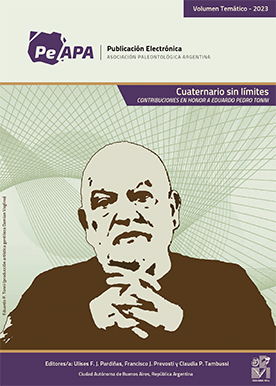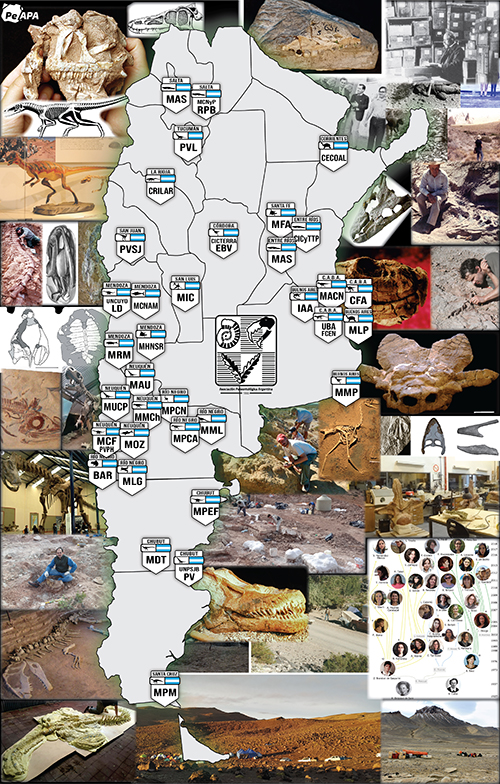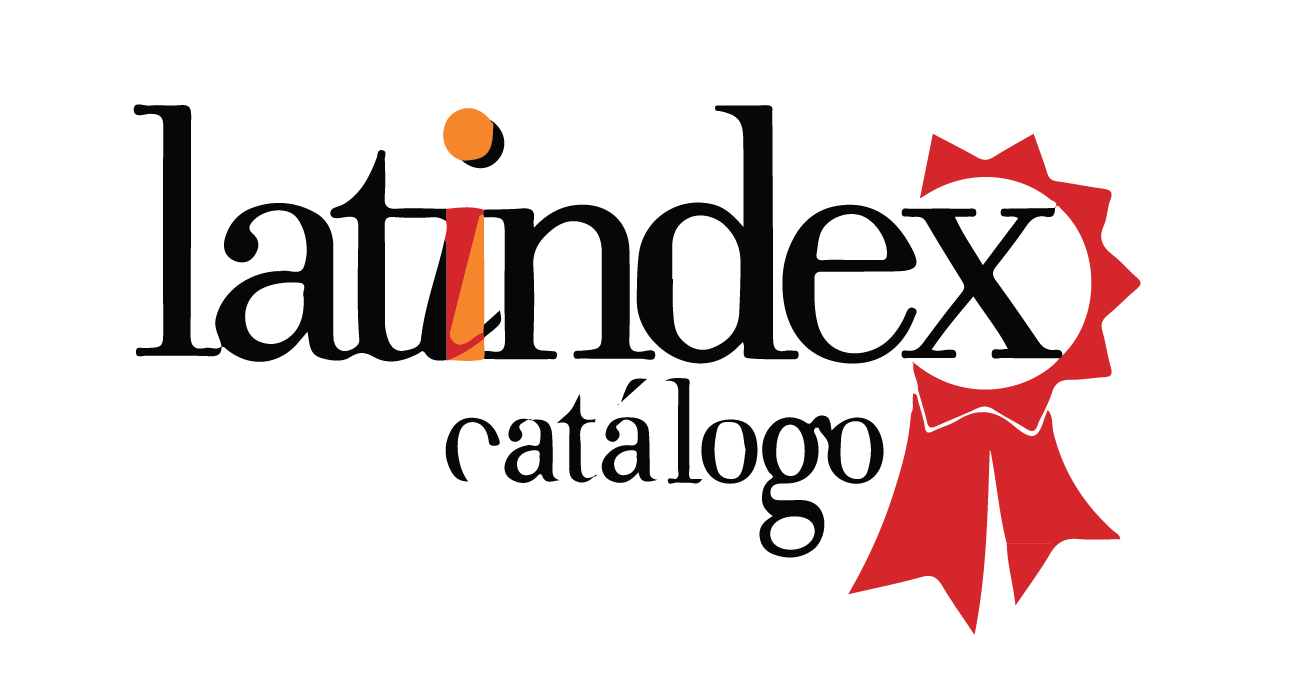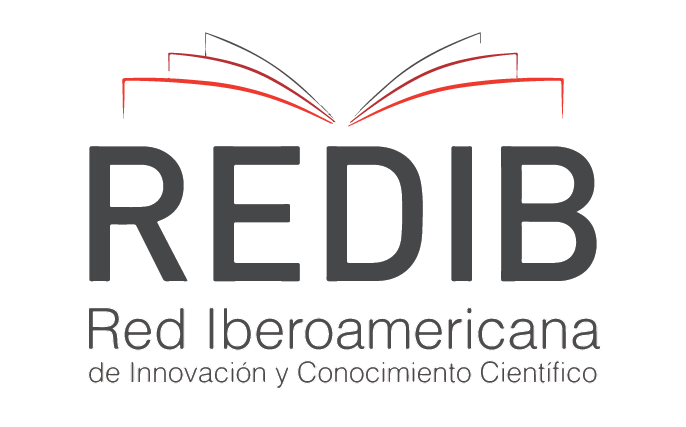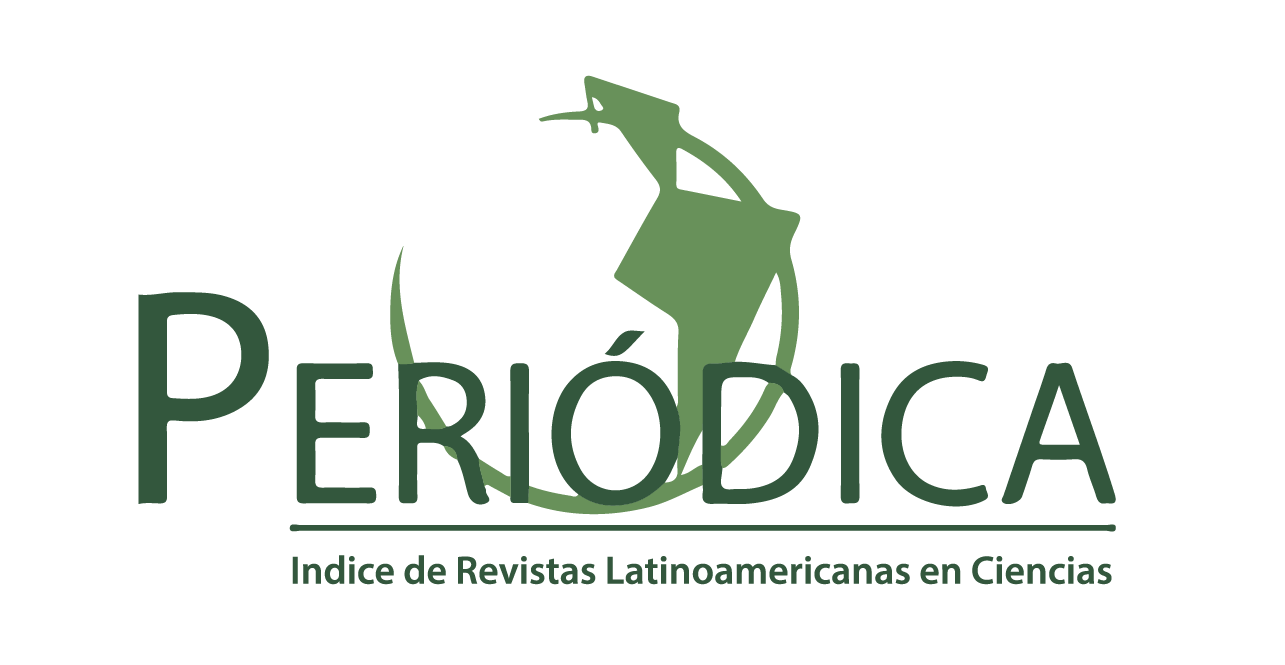RECONSTRUCCIÓN DEL RÉGIMEN DE INCENDIOS EN ECOSISTEMAS TEMPLADOS PATAGÓNICOS SOBRE LA BASE DE REGISTROS DE CARBÓN VEGETAL SEDIMENTARIO (CHARCOAL) Y POLEN DURANTE EL CUATERNARIO TARDÍO. TENDENCIAS METODOLÓGICAS, RESULTADOS Y PERSPECTIVAS
DOI:
https://doi.org/10.5710/PEAPA.23.07.2018.262Abstract
Resumen. La ecología de incendios es una actividad interdisciplinaria concerniente al estudio de los procesos naturales que involucran fuego en los ecosistemas y su interacción con los componentes bióticos y abióticos. Numerosos estudios orientados al conocimiento de la evolución de los ecosistemas naturales y humanos bajo la influencia recurrente del fuego atraviesan el trabajo interdisciplinario en el marco de la Ecología y de las Ciencias de la Tierra. El efecto de los incendios naturales y antrópicos en la evolución del paisaje, su impacto en las comunidades de bosque y la respuesta de los ecosistemas a los incendios son temas de debate y deben ser evaluados en diferentes escalas, tanto temporales como espaciales. En este trabajo se presentan algunos ejemplos que ponen en evidencia en qué medida la metodología aplicada al estudio de la producción, dispersión y depositación del carbón vegetal sedimentario o charcoal en cuencas lacustres y humedales contribuye a dar respuestas a estos interrogantes, se realiza una actualización bibliográfica y se describen algunos ejemplos de los estudios a escala de siglos a milenios, realizados hasta el momento en el sur de América del Sur.
Palabras clave. Paleoecología. Palinología. Métodos de reconstrucción de la historia de incendios. Ecología del fuego. Holoceno. Pleistoceno Tardío.
Abstract. FIRE REGIME RECONSTRUCTION IN PATAGONIAN TEMPERATE ECOSYSTEMS BASED ON CHARCOAL AND POLEN RECORDS DURING THE LATE QUATERNARY. METHODOLOGICAL TRENDS, RESULTS AND PERSPECTIVES. Fire ecology is an interdisciplinary activity concerning the study of natural processes that involve fire interactions with biotic and abiotic components of the ecosystems. Numerous studies focused on the knowledge of the evolution of natural and human ecosystems under the recurrent influence of fire need the interdisciplinary work between Ecology and Earth Sciences. The effect of natural and anthropogenic fires on the evolution of the landscape, its impact on forest communities and the response of ecosystems to fires are topics for debate and should be evaluated at both temporal and spatial scales. In this paper we present some examples that show the extent to which the methodology applied to the study of the production, dispersion and deposition of sedimentary charcoal in lake basins and wetlands contributes to give answers to these debates. We also present some updated references and describe examples of these paleoecological studies focused at centuries to millennia scales in southern South America.
Key words. Paleoecology. Palynology. Fire history reconstruction methods. Fire ecology. Holocene. Late Pleistocene.
References
Abarzúa, A.M. y Moreno, P.I. 2008. Changing fire regimes in the temperate rainforest region of southern Chile over the last 16,000 yr. Quaternary Research 69: 62–71.
Agee, J.K. 1993. Fire ecology of Pacific Northwest forests. Island Press, Washington D.C., 490 p.
Bennett, K.D. 2005. Documentation for Psimpoll 4.25 and Pscomb 1.03: C programs for plotting pollen diagrams and analyzing pollen data. Department of Earth Sciences, University of Uppsala, Uppsala. Available: World Wide Web: http://www.chrono.qub.ac.uk/psimpoll/psimpoll.html
Bianchi, M.M. 2000. Historia de fuego en Patagonia: Registro de carbón vegetal sedimentario durante el Post-glacial y el Holoceno en Lago Escondido (41° S; 72° W). Cuaternario y Ciencias del Ambiente, Asociación Geológica Argentina 1: 23–29.
Bianchi, M.M. 2008. El cambio climático durante los últimos 15.000 años en Patagonia Norte: reconstrucciones de la vegetación en base a polen y carbón vegetal sedimentario. Boletín Geográfico 29: 39–53.
Bianchi, M.M. y Ariztegui, D. 2012. Vegetation history of the Río Manso Superior catchment area, Northern Patagonia (Argentina), since the last deglaciation. The Holocene 22: 1283–1295.
Bianchi, M.M. y Quintana, F.A. 2010. Charcoal Analysis: a methodology to reconstruct fires in natural landscapes at sub-millennial to decadal scales. Preliminary results in the framework of PIPA (MINCyT)-PASADO (ICDP) En: H. Corbella y N.I. Maidana (Eds.), Primera Reunión Internodos del Proyecto Interdisciplinario Patagonia Austral y Primer Workshop Argentino del Proyecto PotrokAikeMaar Lake Sediment Archive Drilling Project. Proyecto Editorial PIPA, Buenos Aires, p. 8–9.
Blaauw, M. 2010. Methods and code for ‘classical’ age-modelling of radiocarbon sequences. Quaternary Geochronology 5: 512–518.
Blaauw, M. y Christen, J.A. 2011. Flexible paleoclimate age-depth models using an autoregressive gamma process. Bayesian Analysis 6: 457–474.
Bowman, D.M.J.S., Balch, J.K., Artaxo, P. et al. 2009. Fire in the Earth System. Science 324: 481–484.
Clark, J.S. 1988. Particle motion and the theory of charcoal analysis, source area, transport, deposition and sampling. Quaternary Research 30: 81–91.
Clark, J.S. y Patterson, A. 1997. Background and local charcoal in sediments: scales of fire evidence in the paleorecord. En: J.S. Clark, H. Cachier, J.G. Goldammer, y B. Stocks (Eds.), Sediment Records of Biomass Burning and Global Change. NATO ASI 1: Global Environmental Change 51, Springer Verlag, Berlin, p. 23–48.
Christensen, N.L. 1993. Fire regimes and ecosystem dynamics. En: P.J. Crutzen y J.G. Goldammer (Eds.), Fire in the Environment: The Ecological, Atmospheric, and Climatic Importance of Vegetation Fires. Wiley, Chichester, p. 233–244.
Colombaroli, D., Vanniere, B., Emmanuel, C. et al. 2008. Fire-vegetation interactions during the Mesolithic-Neolithic transition at Lagodell’ Accesa, Tuscany, Italy. The Holocene 18: 679–692.
Conedera, M., Tinner, W., Neff, C., et al. 2009. Reconstructing past fire regimes: methods, applications, and relevance to fire management and conservation.Quaternary Science Reviews 28: 555–576.
Courtney Mustaphi, C.J. y Pisaric, M.F.J. 2014. A classification for macroscopic charcoal morphologies found in Holocene lacustrine sediments. Progress in Physical Geography38: 734–754. Doi: 10.1177/0309133314548886
De Porras, M.E., Maldonado, A., Abarzúa, A.M. et al. 2012. Postglacial vegetation, fire and climate dynamics at Central Chilean Patagonia (Lake Shaman, 44° S). Quaternary Science Reviews 50: 71–85.
de Porras, M.E., Maldonado, A., Quintana, F.A. et al. 2014. Environmental and climatic changes in central Chilean Patagonia. Climate of the Past 10: 1063–1078.
Di Bella, C.M., Jobbágy, E.G., Paruelo, J.M. et al. 2006. Continental fire density patterns in SouthAmerica. Global Ecology and Biogeography 15: 192–199.
Echeverría, M.E., Sottile, G.D., Mancini, M.V. et al. 2015. Nothofagus forest dynamics and palaeoenvironmental variations during the mid and late Holocene, in southwest Patagonia. The Holocene 24: 957–969. Doi: 10.1177/0959683614534742
Fischer, M.A., Di Bella, C.M. y Jobbágy, E. 2015. Influence of fuel conditions on the occurrence, propagation and duration of wildland fires: A regional approach. Journal of Arid environments 120: 637–71. Doi: 10.1016/j.jaridenv.2015.04.007
Flannigan, M., Cantin, A.S., de Groot, W.J. et al. 2013. Global wildland fire season severity in the 21st century. Fires Ecology and Management 294: 54–61.
Gardner, J.J. y Whitlock, C. 2000. Charcoal accumulation following a recent fire in the Cascade Range, Northwestern USA, and its relevance for fire-history studies. The Holocene 11: 541–549.
Garreaud, R., Nicora, M.G., Bürgesser, R.E., et al. 2014. Lightning in Western Patagonia. Journal of geophysical Research: Atmosphere 9: 4471–4485.
Ghermandi, L., Ghutmann, N. y Bran, D. 2004. Early post-fire succession in northwestern Patagonia grasslands. Journal of Vegetation Science 15: 67–76.
Giaché, Y.S. y Bianchi, M.M. 2018. 13,000 years of forest history in the Río Manso Inferior Valley, Northern Patagonia. Fire-vegetation-humans links. Journal of Archaeological Science Reports 18: 769–774.
Hantson, S., Kloster, S., Coughlan, M. et al. 2016. Fire in the Earth System – bridging data and modelling research.Bulletin of the American Meteorological Society 97: 1069–1072.
Hawthorne, D., Courtney Mustaphi, C.J., Aleman, J.C. et al. 2017. Global Modern Charcoal Dataset (GMCD): A tool for exploring proxy-fire linkages and spatial patterns of biomass burning’.Quaternary International. Doi: http://doi.org/10.1016/
j.quaint.2017.03.046
Henríquez, W.I., Villa-Martínez, R., Villanova, I. et al. 2017. The last glacial termination on the Eastern flank of the central Patagonian Andes (47° S). Climate of the Past 13: 879–895.
Heusser, C.J. 1984. Late-glacial- Holocene climate of the lake district of Chile. Quaternary Research 22: 77–90.
Heusser, C.J. 1987. Fire history of Fuego-Patagonia. Quaternary South America and Antarctic Peninsula 5: 93–109.
Heusser, C.J. 1989. Late Quaternary Vegetation and Climate of Southern Tierra del Fuego. Quaternary Research 31: 396–406.
Heusser, C.J. 1994. Paleoindians and fire during the late Quaternary in southern South America. Revista Chilena de Historia Natural 67: 435–443.
Higuera, P.E., Brubaker L.B., Anderson, P.M. et al. 2009. Vegetation mediated the impacts of postglacial climatic change on fire regimes in the southcentral Brooks Range, Alaska. Ecological Monographs 9: 201–219.
Higuera, P.E., Brubaker, L.B. y Sprugel, D.G. 2005. Reconstructing fire regimes with charcoal from small hollows: a calibration with tree-ring records of fire. The Holocene 15: 238–251.
Higuera, P.E., Peter, M.E., Brubaker, L.B. et al. 2007. Understanding the origin and analysis of sediment-charcoal records with a simulation model. Quaternary Science Reviews 26: 1790–1809.
Holz, A., Méndez, C., Borrero, L. et al. 2016. Fires: the main human impact on past environments in Patagonia? Past Global Changes Magazine 24: 72–73. doi:10.22498/pages.24.2.72
Huber, U.M. y Markgraf, V. 2003. European impact on fire regimes and vegetation dynamics at the steppe-forest ecotone of southern Patagonia. The Holocene 13: 567–579.
Huber, U.M., Markgraf, V. y Schäbitz, F. 2004. Geographical and temporal trends in Late Quaternary fire histories of Fuego-Patagonia, South America. Quaternary Science Reviews 23: 1079–1097.
Iglesias, V., Markgraf, V. y Whitlock, C. 2016. 17,000 years of vegetation, fire and climate change in the eastern foothills of the Andes (lat. 44° S). Palaeogeography, Palaeoclimatology, Palaeoecology 457: 195–208.
Iglesias, V. y Whitlock, C. 2014. Fire responses to postglacial climate change and human impact in northern Patagonia (41-43° S). Proceedings Natural Academy of Science 111: E5545–E5554. Doi: 10.1073/pnas.1410443111
Iglesias, V., Whitlock, C., Bianchi, M.M., et al. 2012a. Climate and local controls of long-term vegetation dynamics in northern Patagonia (Lat 41° S). Quaternary Research 78: 502–512.
Iglesias, V., Whitlock, C., Bianchi, M.M. et al. 2012b. Holocene climate variability and environmental history at the Patagonian forest/steppe ecotone: Lago Mosquito (42.50° S; 71.40° W) and Laguna del Cóndor (42.20° S; 71.17° W). The Holocene 22: 1297–1307.
Iglesias, V., Whitlock, C., Markgraf, V. et al. 2014. Postglacial history of the Patagonian forest/steppe ecotone (41–43° S). Quaternary Science Reviews 94: 120–135.
Kitzberger, T. 2003. Regímenes de fuego en el gradiente bosqueestepa del noroeste de Patagonia: variación espacial y tendencias temporales. En: C. Kunst, S. Bravo, y J. Panigatti (Eds.), Fuego en los ecosistemas argentinos. INTA, p. 79–92.
Kitzberger, T. 2012. Ecotones as complex arenas of disturbance, climate and human impacts: the trans-Andean forest-steppe ecotone of northern Patagonia. En: R. Myster (Ed.), Ecotones between forest and grassland. Springer, Oklahoma State University, Stillwater, p. 59–88.
Kitzberger, T., Aráoz, E., Gowda, J.H., Mermoz, M. y Morales, J.M. 2012. Decreases in fire spread probability with forest age promotes alternative community states, reduced resilience to climate variability and large fire regime shifts. Ecosystems 15: 97–112.
Kitzberger, T., Perry, G.L.W., Paritsis, J. et al. 2016. Fire-vegetation feedbacks and alternative states: common mechanisms of temperate forest vulnerability to fire in southern South America and New Zealand. New Zealand Journal of Botany 54: 247–272.
Kitzberger, T., Veblen, T.T. y Villalba, R. 1997. Climatic influences on fire regimens along a rainforest-to-xeric woodland gradient in northern Patagonia, Argentina. Journal of Biogeography 24: 35–47.
Markgraf, V. y Anderson, L. 1994. Fire history of Patagonia: climate versus human cause. Revista do Instituto Geográfico do Sao Pablo 15: 33–47.
Markgraf, V. y Bianchi, M.M. 1999. Paleoenvironmental changes during the last 17.000 years in western Patagonia: Mallin Aguado, Province of Neuquén, Argentina. Bamberger Geographische Schriften 19: 175–193.
Markgraf, V., Iglesias, V. y Whitlock, C. 2013. Late and postglacial vegetation and fire history from Cordón Serrucho Norte, northern Patagonia. Palaeogeography, Palaeoclimatology, Palaeoecology 371: 109–118.
Markgraf, V., Whitlock, C., Anderson, R.S. et al. 2009. Late Quaternary vegetation and fire history in the northernmost Nothofagus forest region: Mallín Vaca Lauquen, Neuquén Province, Argentina. Journal of Quaternary Science 24: 248–258.
Markgraf, V., Whitlock, C. y Haberle, S. 2007.Vegetation and fire history during the last 18,000 cal yr B.P. in Southern Patagonia: Mallín Pollux, Coyhaique, Province Aisén (45° 41’ 30″ S, 71°50′ 30″ W, 640 m elevation). Palaeogeography, Palaeoclimatology, Palaeoecology 254: 492–507.
Marlon, J.R., Bartlein, P.J., Daniau, A.-L. et al. 2013. Global biomass burning: A synthesis and review of Holocene paleofire records and their controls. Quaternary Science Review 65: 5–25.
Méndez, C., de Porras, M.E., Maldonado, A. et al. 2016. Human Effects in Holocene Fire Dynamics of Central Western Patagonia (∼44° S , Chile). Frontiers in Ecology and Evolution 4: 1–19.
Moreno, P.I. 2000. Climate, Fire and vegetation between about 13,000 and 9200 14C yr in the Chilean Lake district. Quaternary Research 54: 81–89.
Moreno, P.I. y Videla, J. 2016. Centennial and millennial- scale hydroclimate changes in northwestern Patagonia since 16,000yr BP. Quaternary Science Reviews 149: 326–337.
Moreno, P.I., Kitzberger, T., Iglesias, V., et al. 2010. Paleofires in southern South America since the Last Glacial Maximum. Past Global Changes Magazine 18: 75–77.
Moreno, P.I., Villanova, I., Villa-Martínez, R., et al. 2014. Southern Annular Mode- linkages changes in southwestern Patagonia at centennial timescales over the last three millennia. Nature communications. Doi: 10.1038/ncomms5375.
Morrison, P. y Swanson, F.J. 1990. [Fire History and pattern in a Cascade Range landscape. General Technical Report: PNW-GTR-254of the U.S. Department of Agriculture, Forest Service, Portland, 77 p. Inédito.].
Paritsis, J., Veblen, T.T. y Holz, A. 2014. Positive feedbacks contribute to shifts from Nothofagus pumilio forests to fire-prone shrublands in Patagonia. Journal of Vegetation Science 26: 89–101.
Peters, M.E. e Higuera, P.E. 2007. Quantifying the source area of macroscopic charcoal with a particle dispersal model. Quaternary Research 67: 304–310.
Power, M.J., Marlon, J.R., Bartlein, P.J. et al. 2010. Fire history and the global charcoal database: a new tool for hypothesis testing and data exploration. Palaeogeography, Palaeoclimatology, Palaeoecology 291: 52–59.
Quintana, F.A. y Bianchi, M.M. 2010. Macroscopic charcoal analysis from lacustrine sediments as a methodology to reconstruct fire history: First results from Santa Cruz (50°–52° S). Argentina. Terra Nostra Schriften der GeoUnion Alfred Wegener-Stiftung 1: 56–57.
R Development Core Team, 2013. R: A language and environment for statistical computing. R Foundation for Statistical Computing, Vienna, Austria. ISBN 3-900051-07-0, World Wide Web: http://www.rproject.org
Romme, W. 1980. [Fire history terminology: report of the ad hoc committee. General Technincal Report RM-GTR-81 of the U.S: Department of Agriculture, Forest Service, Arizona, 142 p. Inédito.].
Simi, E., Moreno, P.I., Villa-Martínez, R. et al. 2017. Climate change and resilience of deciduous Nothofagus forests in central–east Chilean Patagonia over the last 3200 years. Journal of Quaternary Science 32: 845–856.
Sottile, G.D. 2014. [Historia de la vegetación vinculada a disturbios de incendios durante el Holoceno en el ecotono bosque- estepa de Santa Cruz, Argentina. Tesis Doctoral. Facultad de Ciencias Exactas y Naturales. Universidad Nacional de Mar del Plata, Buenos Aires, 145 p. Inédita.].
Sottile, G.D., Bamonte, F.P., Mancini, M.V., et al. 2012. Insights into Holocene vegetation and climate changes at the southeast of the Andes: Nothofagus forest and Patagonian steppe fire records. The Holocene 22: 1309–1322.
Sottile, G.D., Echeverría, M.E., Mancini, M.V., et al. 2015b. Eastern Andean environmental and climate synthesis for the last 2000 years BP from terrestrial pollen and charcoal records of Patagonia. Climate of the Past discussions 11:2121-2157. World Wide Web: https://doi.org/10.5194/cpd-11-2121-2015
Sottile, G.D, Meretta, P.E., Tonello, M.S., et al. 2015a. Disturbance induced changes in species and functional diversity in southern Patagonian forest-steppe ecotone. Forest Ecology and Management 353: 7–86.
Tepley, A.J., Veblen, T.T., Perry, G.L.W., et al. 2016. Positive feedbacks to fire-driven deforestation following human colonization of the South Island of New Zealand. Ecosystems Doi: 10.1007/s10021-016-0008-9.
Tinner, W., Hubschmid, P., Wehrli, M., et al. 1999. Long-termforest fire ecology and dynamics in southern Switzerland. Journal of Ecology 87: 273–289.
Vannière B., Blarquez O., Marlon J., et al. 2014. Multi-Scale Analyses of Fire-Climate-Vegetation Interactions on Millennial Scales. Past Global Changes Magazine 22: 40.
Veblen, T.T., Kitzberger, T., Villalba, R., et al. 1999. Fire History in Northern Patagonia: The Roles of Humans and Climatic Variation. Ecological Monographs 69: 47–67.
Villa-Martínez, R., Moreno, P.I. y Valenzuela, M.A. 2012. Deglacial and postglacial vegetation changes on the eastern slopes of the central Patagonian Andes (47° S). Quaternary Science Reviews 32: 86–99.
Whelan, R.J. 1995. The Ecology of Fire. Cambridge University Press, Cambridge, 346 p.
Whitlock, C. y Millspaugh, S.H. 1996. Testing assumptions of fire history studies: an examination of modern charcoal accumulation in Yellowstone National Park. The Holocene 6: 7–15.
Whitlock, C. y Larsen, C. 2001. Charcoal as a fire proxy. En: J. Smoll, J.B. Birks, y W. Last (Eds.), Tracking Environmental Change using Lake sediments, Volume 3: Terrestrial, Algal, and Siliceous Indicators. Kluwer Academic Publishers, Dordrecht, p. 85–97.
Whitlock, C., Bianchi, M.M., Marlon, J., et al. 2006. Postglacial vegetation, climate, and fire history along the east side of the Andes (lat 41–42.5° S), Argentina. Quaternary Research 66: 187–201.
Whitlock, C., Higuera, P.E., McWethy, D.M., et al. 2010. Paleoperspectives on fire ecology: revisiting the fire regime concept. The Open Ecology Journal 3: 6–23.
Whitlock, C., McWethy, D.B., Tepley, A.J., et al. 2014. Past and present vulnerability of closed-canopy temperate forest to altered fire regimes: a comparison of the Pacific Northwest, New Zealand and Patagonia. Bioscience 65: 151–163.
Whitlock, C., Moreno, P.I. y Bartlein, P. 2007. Climatic controls of Holocene fire patterns in southern South America. Quaternary Research 68: 28–36.
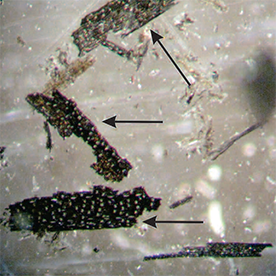
Downloads
Additional Files
Published
Issue
Section
License
Copyright (c) 2018 Publicación Electrónica de la Asociación Paleontológica Argentina

This work is licensed under a Creative Commons Attribution-NoDerivatives 4.0 International License.

Authors retain copyright and grant the journal right of first publication with the work simultaneously licensed under a CC Attribution-NonCommercial 4.0 that allows others to share the work with an acknowledgement of the work's authorship and initial publication in this journal.







